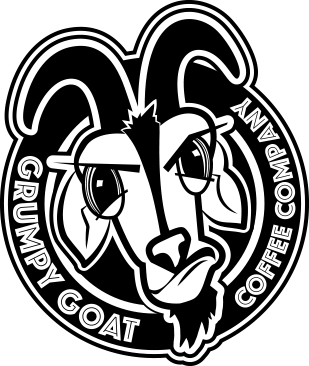Espresso’s Dark Hidden Secret
We get the question from customers all the time. Do you have espresso beans?
Most people expect to hear a yes or no answer.
But it’s not that simple.
We gently coach people that espresso is not a type of bean or a specific roast type.
It’s a type of grind and brew method.
You will see it as a setting on many coffee grinders and it results in a finer grind.
Any coffee beans can be ground to an espresso level of fineness. That doesn’t mean that every coffee bean makes a great cup of espresso.
Which brings us back to the premise that Grumpy Goat loves to teach coffee lovers about.
A main key to the perfect cup of coffee is the quality and freshness of the coffee beans.
Espresso is widely popular. The power of marketing and messaging has taught us that it is a special coffee experience. Espresso lovers have come to cherish the crema that forms on the surface of their espresso style coffee.
What exactly is espresso?
There’s more to the espresso story than meets the eye.
In fact, there’s a dark hidden secret about traditional espresso.
It has to do with the coffee beans used to make it.
Typically, espresso is a blend of arabica coffee beans with some robusta coffee beans.
Robusta beans, although low quality and almost undrinkable on their own, serve two important roles in the making of an espresso.
First, the robusta beans contain about double the caffeine of arabica beans.
Second, it’s the robusta bean that allows for a thicker crema to form on top.
What really defines an espresso is how it is brewed, and that’s why the grind type is critical.
The grind size for espresso is very fine. This fineness creates a more compact surface area and resistance for the pressurized hot water to flow through. This process results in a more intense and concentrated coffee experience.
An espresso machine is designed to create pressurized extraction as it forces hot water under very high pressure through a compressed bed of roasted, ground coffee.
This style of coffee is widely popular, helped along with mass marketing that this is how a great cup of coffee should be experienced and thereby creating a use for robusta coffee beans that are bitter on their own.
The secret behind espresso crema
Espresso style coffee is known for the thick foamy crema that forms on the surface of the coffee.
Reddish and caramel in color, the tiny bubbles of the crema are visually appealing and make for great Instagram posts.
But the carbon dioxide gas in the crema contributes to the bitterness of the espresso taste.
So, it’s not uncommon to have an attractive looking espresso with a less than desired taste.
See for yourself and try scraping the foam away and letting the coffee stand on its own. Or, mix the crema in and experience an entirely different flavor profile.
Either way, know that you can enjoy a strong cup of espresso without an overly thick crema as long as you are using fresh, high quality coffee beans.
Does Grumpy Goat have espresso beans?
 It’s a valid question and we are happy to answer and offer advice.
It’s a valid question and we are happy to answer and offer advice.
But it all starts with the origin, quality and freshness of the beans.
Grumpy Goat focuses solely on high quality, single origin, fully traceable coffee beans. No blending, no flavoring, no risk of mishandling.
There are several Grumpy Goat coffee origins that will make a great espresso style experience.
Examples include Colombian, Ethiopian, Kenyan and Sumatra and although traditionally most people would opt for a dark roast, do not be afraid to try making an espresso with a medium roast.
In fact, many coffee-forward cultures such as in Scandinavia, have fully embraced enjoying espresso style coffee using single origin beans and using lighter roast profiles than the traditional Italian espresso.
There’s no right or wrong here. It boils down to your personal taste and we encourage you to experiment and land on what types of coffee fit best with your palate.
But without the blending of the robusta beans you are unlikely to see the same thick, foamy lid form on the surface of your cup. Not to say there won’t be some crema – there will be – just not the same as when the low quality robusta beans are blended in.
The crema is arguably a mask that inhibits the true tasting notes of the beans from being experienced. If you’re using low quality beans then perhaps the crema is a nice complement to hedge against the bitterness.
But when you’re using high quality coffee beans you want that flavor profile to shine.
And remember, it’s the marketing that has “taught” us that the crema is what makes espresso special.
We think it’s still all about the coffee.



